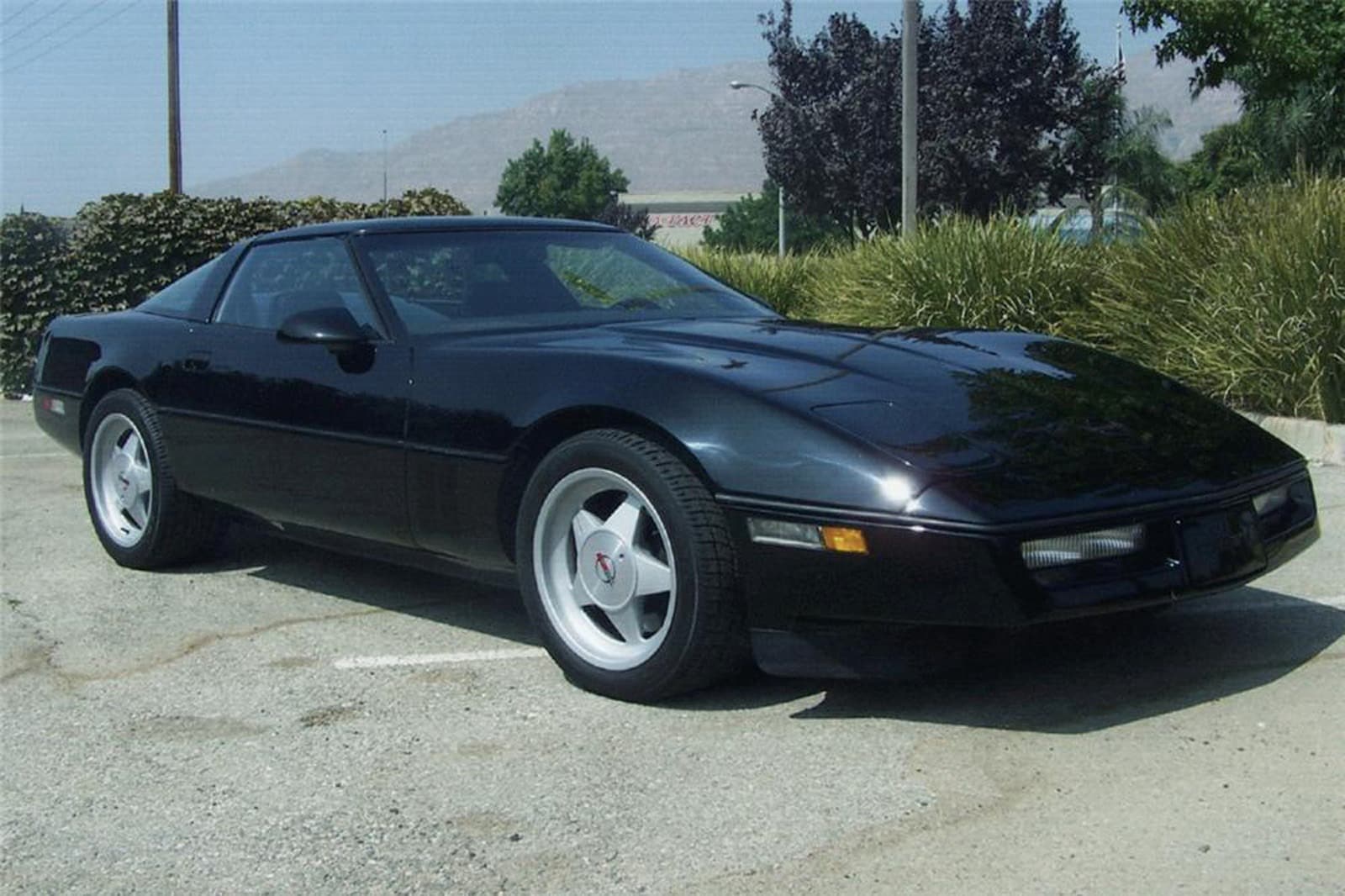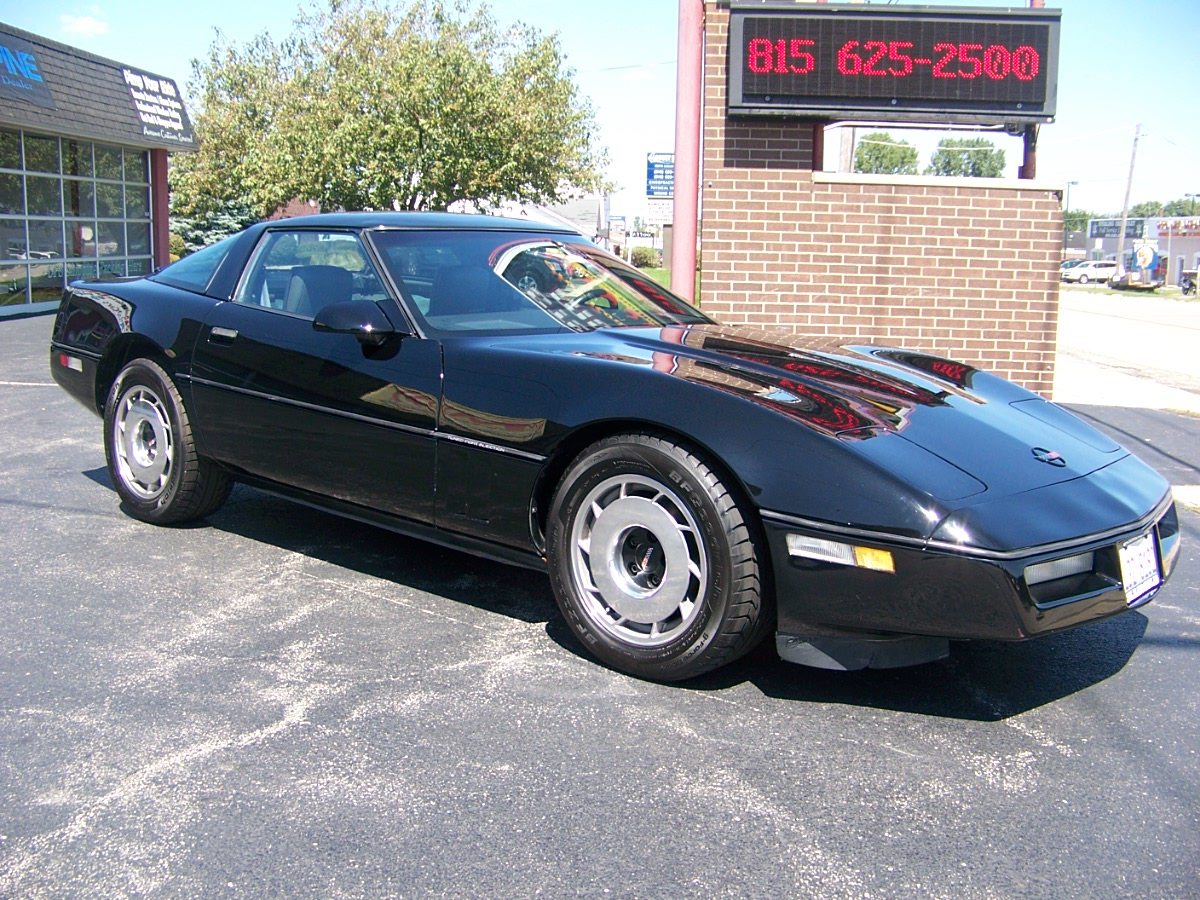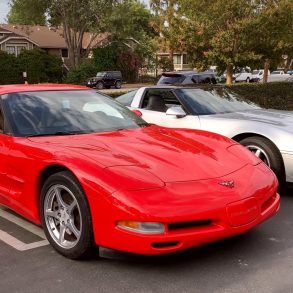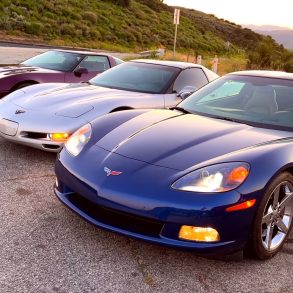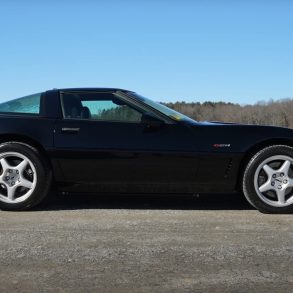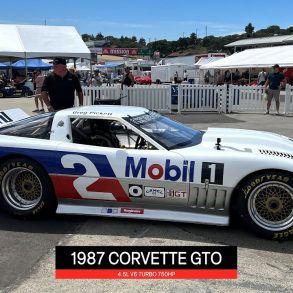The information contained on this page is for reference only and may contain incomplete or outdated information. Read more: 1987 Corvette guide.
1987 Corvette Recalls
Recall 06e043000
Make: Chevrolet
Model: Corvette
Model Year: 1987
Manufacturer: Honeywell International, Inc.
Mfr’s Report Date: May 19, 2006
Nhtsa Campaign Id Number: 06e043000 N/a
Nhtsa Action Number: N/a
Component: Fuel System, Gasoline
Potential Number Of Units Affected: 88303
Summary
Certain Replacement Fuel Filters, Fram Brand Name P/n G3727, With Date Codes X52911 Through X60801 Sequentially Or X600141 And A Mexico Country Or Origin Marking On The Fuel Filter Housing Manufactured From October 18, 2005, Through March 21, 2006, Sold For Use On The Vehicles Listed Above And On Certain School Buses. (To See The School Bus Engine Sizes, Click On “Document Search” And Then “Bus Applications”). The Connector On The Fuel Filter Was Not Manufactured To Honeywell’s Specification. As A Result, The O-ring May Not Seat Correctly On The Fuel Line.
Consequence
This Condition May Cause An Inadequate Seal At The Connection, Potentially Leading To A Fuel Leak. In The Presence Of An Ignition Source, A Fire Could Occur.
Remedy
Honeywell Will Notify Owners And Replace The Fuel Filters Free Of Charge. The Recall Began On October 18, 2006. Owners May Contact Fram Customer Service At 1-800-890-2075 (Option 1).
Notes
This Recall Only Pertains To Aftermarket Fram Fuel Filters And Has No Relation To Any Original Equipment Installed On The Vehicles Listed. Customers May Contact The National Highway Traffic Safety Administration’s Vehicle Safety Hotline At 1-888-327-4236 (Tty: 1-800-424-9153); Or Go To http://www.safercar.gov.
Recall 07e088000
Make: Chevrolet
Model: Corvette
Model Year: 1987
Manufacturer: Honeywell International, Inc.
Mfr’s Report Date: Oct 19, 2007
Nhtsa Campaign Id Number: 07e088000
Nhtsa Action Number: N/a
Component: Equipment
Potential Number Of Units Affected: 121680
Summary
Certain Honeywell Fram Racing Brand Hp4 And Hp8 Oil Filters That Were Manufactured From May 25, 2006, Through September 14, 2007, And Sold For Use As Replacement Equipment For Vehicles List Above. The Affected Filters Are Marked With A Date Code A61451 Through A72571 Sequentially. The Date Code And Part Number Appear On The Filter Housing. Fram Racing Hp4 And Hp8 Oil Filters Not Bearing A Date Code In This Range Are Not Affected By This Recall. The Gasket Of The Oil Filter Becomes More Pliable Under High Temperatures And Pressures.
Consequence
This Condition May Cause Inadequate Sealing And Loss Of Engine Oil, Possibly Resulting In A Fire.
Remedy
Honeywell Will Replace The Affected Oil Filters Free Of Charge. The Recall Began During November 2007. Owners Can Contact Fram Customer Service Toll-free At 1-800-890-2075.
Notes
Customers May Contact The National Highway Traffic Safety Administration’s Vehicle Safety Hotline At 1-888-327-4236 (Tty: 1-800-424-9153); Or Go To http://www.safercar.gov.
Recall 91v143000 Ea90033
Make: Chevrolet
Model: Corvette
Model Year: 1986
Manufacturer: General Motors Corp.
Mfr’s Report Date: Aug 26, 1991
Nhtsa Campaign Id Number: 91v143000 Ea90033
Nhtsa Action Number: Ea90033
Component: Seat Belts:front:anchorage
Potential Number Of Units Affected: 231833
Summary
Under Certain Vehicle Operations And Occupant Usage Conditions, The Safety Belts Can Lockup Or Jam In The Safety Belt Retractor.
Consequence
If Lockup Occurs, It Is Impossible To Pull Belt Out Of the Retractor. The Occupant Of A Seat With An Unusable Safety Belt Is subject To Increased Risk Of Injury Or Death In The Event Of A Sudden Stop Or accident.
Remedy
Replace The Safety Belts If The Lockup Occurs.
Notes
System: Safety Belts.vehicle Description: Passenger Cars.
1987 Corvette Service Bulletins
Service Bulletin 01697
Make: Chevrolet
Model: Corvette
Model Year: 1987
Manufacturer: General Motors Corp.
Service Bulletin Number: 01697
Date of Bulletin: Jan 01, 2004
NHTSA Item Number: 10006297
Component
Equipment: Electrical
Summary
No serial data communications using the tech 1 with a 1986 or newer Camaro, Firebird or Corvette with a 5.0 or 5.7 litre engine. Sit bulletin 1450640.
Service Bulletin 9313110
Make: Chevrolet
Model: Corvette
Model Year: 1987
Manufacturer: General Motors Corp.
Service Bulletin Number: 9313110
Date of Bulletin: Mar 01, 1993
NHTSA Item Number: 39547
Component
Visibility: Glass, Side/Rear
Summary
Rear lift window hard to open/hinge loose to glass.
1987 Corvette Common Issues
The following list of common issues is intended for individual reference only, and may not reflect the specific issues of every 1987 Corvette. This information comes from a variety of sources including the NHTSA Defects Reports pages. While the intent of this page is to identify the common issues pertaining to the 1987 Corvette, it is not an all-inclusive list and should be used for reference only.
Read more: 1987 Corvette Common Issues.
1987 Corvette Maintenance Schedule
Maintenance Schedule
Schedule 1
Follow Schedule 1 if your car is mainly operated under one or more of the following conditions:.
- When most trips are less than 4 miles (6 kilometers)
- When most trips are less than 10 miles (16 kilometers) and outside temperatures remain below freezing.
- Idling for extended periods and/or low-speed operation such as found in delivery, police, rental or taxi operation.
- Towing a trailer.
- Operating in dusty areas.
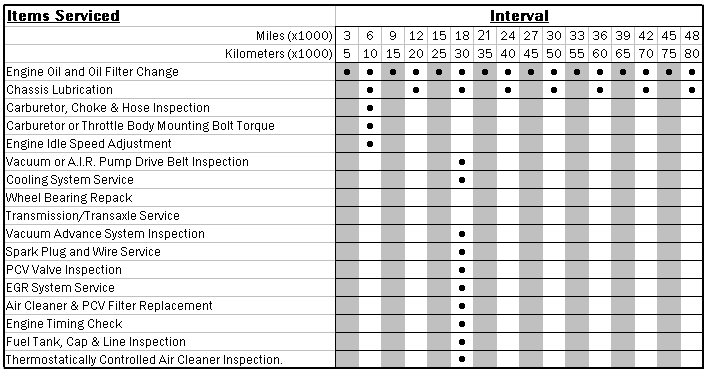
Schedule 2
Follow Schedule 2 only if none of the driving conditions specified in Schedule 1 apply

Additional Maintenance and Lubrication
While Operating Your Vehicle
Automatic Transmission Shift Indicator Position – Make sure the indicator points to the gear chosen.
Horn Operation – Blow the horn occasionally to make sure it works. Check all button locations.
Brake System Operation – Be alert to abnormal sounds, increased brake pedal travel or repeated pulling to one side when braking. Also, if a brake warning light comes on or flashes, or the anti-lock (if equipped) comes on or remains on, something may be wrong with part of the braking system. Have it inspected and repaired at once.
Exhaust System Operation – Be alert to any changes in the sound of the system or any smell of fumes. These are signs the system may be leaking or overheating. Have it inspected and repaired at once. Also see “Engine Exhaust Gas Caution (Carbon Monoxide)” and “Catalytic Converter” in your Owner’s Manual.
Tire and Wheel Operation – Be alert to a vibration of the steering wheel or seat at normal highway speeds. This may mean a wheel balance is needed. Also, a pull right or left on a straight, level road may show the need for a tire pressure adjustment or wheel alignment.
Steering System Operation – Be alert to changes in steering action. An inspection is needed when the steering wheel is harder to turn or has too much free play or if unusual sounds are noted when turning or parking.
Headlight Aim Operation – Take note of light pattern occasionally. If beam aim doesn’t look right, headlights should be aligned.
At Each Fuel Fill:
Engine Oil Level Check – Check engine oil level and add if necessary. See your Owner’s Manual for further details. NOTE: A large loss of oil in this system may indicate a problem. Have it inspected and repaired at once.
Engine Coolant Level and Condition – Check engine coolant level in coolant reservoir tank and add if necessary. Replace if dirty or rusty. See your Owner’s Manual for further details. NOTE: A large loss in this system may indicate a problem. Have it inspected and repaired at once.
Windshield Washer Fluid Level Check – Check washer fluid level in container and add if necessary.
At Least Monthly:
Tire Pressure Check – Keep pressures as shown on Tire Placard on the driver’s door (include spare unless it is a stowaway). Pressure should be checked when tires are “cold”.
Light Operation Check – Check operation of license plate light, side-marker lights, headlights including high beams, parking lights, taillights, brake lights, turn signals, backup lights, instrument panel and interior lights and hazard warning flashers.
Fluid Leak Check – After the car has been parked for a while, inspect the surface beneath the car for water, oil, fuel or other fluids. Water dripping from the air conditioning system after use is normal. If you notice fuel leaks or fumes, the cause should be found and corrected at once.
At Least Twice A Year (for example: Every Spring and Fall):
Power Steering Pump Fluid Level Check – Check power steering pump fluid level in accordance with Owner’s Manual instructions and keep at proper level. NOTE: A large loss in this system may indicate a problem. Have it inspected and repaired at once.
Brake Master Cylinder Reservoir Fluid Level Check – Check fluid and keep at proper level. NOTE: A low fluid level can indicate worn disc brake pads which may need to be serviced. NOTE: A large loss in this system may indicate a problem. Have it inspected and repaired at once.
Clutch System Service – Manual Transmissions – For cars equipped with hydraulic clutch systems, check the reservoir fluid level and add fluid as required. All others, check clutch pedal free travel and adjust as necessary. See your Owner’s Manual for further detail. NOTE: A large loss in this system may indicate a problem. Have it inspected and repaired at once.
Each Time Oil Is Changed:
Automatic and Manual Transmission/Transaxle Fluid Level Check – Check transmission/transaxle fluid level and add as required. If equipped with manual transmission – check fluid in the overdrive unit and add as required. NOTE: A large loss in this system may indicate a problem. Have it inspected and repaired at once.
Tire and Wheel Inspection and Rotation – Check tires for abnormal wear or damage. Also, check for damaged wheels. To equalize tire wear and obtain maximum tire life, it is suggested that tires be rotated at 7,500 miles (12,500 kilometers) followed by 15,000 miles (25,000 kilometers) thereafter. See “Tires” in owners manual for further information.
Brake Systems Inspection – For convenience, the following should be done when wheels are removed for rotation: Inspect lines and hoses for proper hookup, binding, leaks, cracks, chafing, etc. Inspect disc brake pads for wear and rotors for surface condition. Also inspect drum brake linings for wear and cracks (if applicable). Inspect other brake parts, including drums, wheel cylinders, parking brake, etc. at the same time. Check parking brake adjustment. INSPECT BRAKES MORE OFTEN IF DRIVING HABITS OR CONDITIONS RESULT IN FREQUENT BRAKING.
Steering, Suspension and Front Drive Axle Boot and Seal Inspection – Inspect front and rear suspension and steering system for damaged, loose or missing parts, signs of wear or lack of lubrication. Inspect power steering lines and hoses for proper hookup, binding, leaks, cracks, chafing, etc. (On cars equipped with manual steering gear, check for seal leakage.) Replace seals if necessary.
Exhaust System Inspection – Inspect complete system. Inspect boy near the exhaust system. Look for broken, damaged, missing or out-of-position parts as well as open seams, holes, loose connections or other conditions which could cause a heat build up in the floor pan or could let exhaust fumes seep into the trunk or passenger compartment.
Throttle Linkage Inspection – Inspect for interference, binding , damaged or missing parts.
Engine Drive Belts Inspection – Inspect all belts for cracks, fraying and wear. Adjust or replace as needed.
Rear Axle Service – Check gear lubricant level and add if needed. Cars equipped with limited-slip differential should have gear lubricant and any required additives drained and refilled at 7,500 miles (12,500 kilometers). See your Owner’s Manual. IF YOU USE YOUR CAR TO PULL A TRAILER, CHANGE GEAR LUBRICANT EVERY 7,500 MILES (12,500 KILOMETERS). NOTE: A large loss in this system may indicate a problem. Have it inspected and repaired at once.
Power Antenna – Clean and then lubricate power antenna mast. The proper lubricant should be used.
At Least Once A Year:
Lap and Shoulder Belts Condition and Operation – Inspect belt system, including webbing, buckles, latch plates, retractors, guide loops and anchors.
Seatback Latch and Recliner Operation – Be sure seatbacks latch using mechanical latches. Make sure the recliner is holding by pushing and pulling on the top of the seatback while it is reclined. See your Owner’s Manual for seat operating information.
Spare Tire and Jack Storage – Be alert to rattles in rear of car. Make sure the spare tire, all jacking equipment, any tire inflator and any covers or doors are securely stowed at all times. Oil jack ratchet or screw mechanism after each use.
Key Lock Service – Lubricate key lock cylinder at least annually.
Body Lubrication Service – Lubricate all body door hinges including the tailgate (if equipped). Also lubricate the body hood, fuel door and rear compartment hinges and latches including interior glove box and counsel doors, and any folding seat hardware.
Starter Safety Switch Operation – CAUTION: Before performing the following safety switch check, be sure to have enough room around the car. Then, firmly apply both the parking brake (see your Owner’s Manual for procedure) and the regular brakes. Do not use the accelerator pedal. If the engine starts, be ready to turn off the ignition promptly. Take these precautions because the car could possibly move without warning and possibly cause personal injury or property damage. On automatic transmission cars, try to start the engine in each gear. The starter should crank only in “Park” or “Neutral”. On manual transmission cars, place the shift lever in “Neutral”, push the clutch halfway and try to start. The starter should crank only when the clutch is fully depressed.
Steering Column Lock Operation – While parked, try to turn key to “Lock” in each gear range. The key should turn to “Lock” only when gear is in “Park” on automatic or “Reverse” on manual transmissions. On cars with key release lever, try to turn key to “Lock” without depressing the lever. The key should turn to “Lock” only with the key lever depressed. On all vehicles, the key should come out only in “Lock”.
Parking Brake an Transmission “Park” Mechanism Operation – CAUTION: Before checking the holding ability of the parking brake and automatic transmission “Park” mechanism, park on a fairly steep hill with enough room for movement in the downhill direction. To reduce the risk of personal injury or property damage, be prepared to apply the regular brakes promptly if the car begins to move. To check the parking brake, with the engine running and the transmission in “Neutral”, slowly remove foot pressure from the regular brake pedal (until the car is only held by the parking brake.) To check the automatic transmission “Park” mechanism holding ability, release all brakes after shifting the transmission to “Park”.
Underbody Flushing – At least every spring, flush from the underbody with plain water any corrosive materials used for ice and snow removal and dust control. Take care to thoroughly clean any areas where mud and other debris can collect. Sediment packed in closed areas of the vehicle should be loosened before being flushed.
Engine Cooling System Service – Inspect coolant and freeze protection. If dirty or rusty, drain, flush and refill with new coolant. Keep coolant at the proper mixture as specified in your Owner’s Manual. This provides proper freeze protection, corrosion inhibitor level and engine operating temperature. Inspect hoses and replace if cracked, swollen or deteriorated. Tighten hose clamps. Clean outside of radiator and air conditioning condenser. Wash radiator filler can and neck. To help ensure proper operation, a pressure test of both the cooling system and cap is also recommended.
1987 Corvette DIY Service Guide
Battery & Charging
Inspection & Replacement of Battery, Factory Battery Specifications, Replacement of Alternator/Generator
Belt & Tensioner
How to Replace Drive Belt(s), Inspection & Replacement of Upper/Lower Radiator Hoses
Braking
Inspection & Replacement of Brake Pads, Inspection & Replacement of Front/Rear Brake Rotors, How to Replace Brake Calipers, How to Bleed Brakes, Inspection & Replacement of Master Cylinder
Heating & Cooling
Inspection & Replacement of Radiator, How to Replace the Heater Core, Inspection & Replacement of Upper/Lower Radiator Hoses, How to Flush the Cooling System, How to Replace the Water Pump, How to Replace a Thermostat
Emissions
Location of, Inspection & Replacement of Oxygen Sensors (Upstream/Downstream), How to Replace the EGR Valve, How to Replace the Smog Pump
Filters/PCV Valves
Location & Replacement of the Following Filters: Oil Filter, Fuel Filter, Transmission Filter, PCV Valve
Ignition & Tune Up
How to Replace the Ignition Coil, How to Replace the Ignition Switch, Inspection & Replacement of Sparkplug Wires, Inspection & Replacement of Cap & Rotor, How to Replace Sparkplugs, Engine Firing Order, Engine Timing
Relays & Sensors
Location & Replacement of: Mass Air Flow Sensor, Oil Pressure Sensor, Engine Temperature Sensor, Ambient Air Temperature Sensor, Fuel Pressure Sensor, Oxygen Sensors (Upstream/Downstream)
Suspension & Steering
Inspection & Replacement of Upper/Lower Ball Joints, How to Replace Control Arm Bushings, How to Replace the Power Steering Pump, Inspection & Replacement of Front Shocks/Struts, Inspection & Replacement of Rear Shocks/Struts, How to Replace Inner & Outer Tie Rod Ends
Starter/External Engine
How to Replace the Starter Motor, How to Replace the Starter Solenoid, How to Replace the Drive Belt Tensioner, How to Replace the Idler Pulley, Location of, Inspection & Replacement of Engine (Motor) Mounts, How to Replace the Oil Pan Gasket, How to Replace the Oil Pump
Transmission & Clutches
How to Change the Transmission Filter (Automatic Transmission), How to Replace a Clutch (Manual Transmission)


